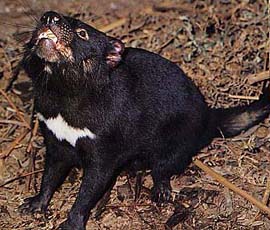Tasmanian Devil

(Sarcophilus harrisii)
Geographic Range
Australian: Today, S. laniarius is found only in Tasmania, although fossil evidence suggests that it once occupied much of the Australian mainland. It has been hypothesized that its absence in many areas which it previously occupied can be explained by competition with the introduced dingo.
Physical Characteristics
Mass: 4 to 9 kg.
Stocky with a brownish black pelage, the Tasmanian Devil resembles a small bear. They have a white throat patch and white spots on the sides and backside, and a pinkish snout. The head is massive with well developed jaw muscles. Molar teeth are heavy and adapted for their role in crushing bone. Females are slightly lighter than males.
Food Habits
The Tasmanian Devil has an unwarranted reputation as a savage beast. In reality, these marsupials take most of their large prey such as wombats, sheep, and rabbits, in the form of carrion. It is an efficient scavenger, eating even bones and fur. Other food items, such as insects, insect larvae, snakes, and small amounts of vegetative matter, are taken when encountered. The Tasmanian devil forages in a slow, lumbering manner, using its sense of smell to find food at night.

Reproduction
The Tasmanian devil is monestrous. Most mating takes place in March, with females at least two years old. Litter size is usually between 2 and 4, gestation taking about a month. The young then travel to the pouch where they remain for about three and a half months. By eight months, the young are completely weaned.
Behavior
Tasmanian devils are nocturnal and usually solitary. Occasionally, when individuals congregate at food sources such as carrion, they interact aggressively but they are not territorial. When fighting, Tasmanian devils vocalize with growls, screeches, and vibratos. There also seems to be a learned dominance hierarchy, at least in captive situations.
Both males and females make nests of bark, grass and leaves which they inhabit throughout the day.
Habitat
Tasmanian devils are numerous throughout Tasmania except in areas where there has been extensive habitat fragmentation and deforestation. They are most numerous in coastal heath. Their dens typically are located in hollow logs, caves, or burrows.
Biomes: temperate forest & rainforest
Economic Importance for Humans
Negative
The Tasmanian devil has been though a nuisance and money has been spent in the past to control numbers. This money is most likely wasted since Tasmanian Devils do not actually kill livestock as was once thought.
Conservation
Status: no special status
At one time, the Tasmanian Devil was thought to be in danger of extinction due to persecution by settlers and destruction of forest habitat. In recent years, populations are recovering due to increased amounts of carrion as a result of the livestock and commercial trapping industries.
Other Comments
Unlike many other members of this family, the pouch is completely closed when breeding. Tasmanian devils live up to about 8 years. This species is usually called S. harrisii, but Wilson and Reeder (1993) have chosen to call it S. laniarus based on reasoning found in another reference.